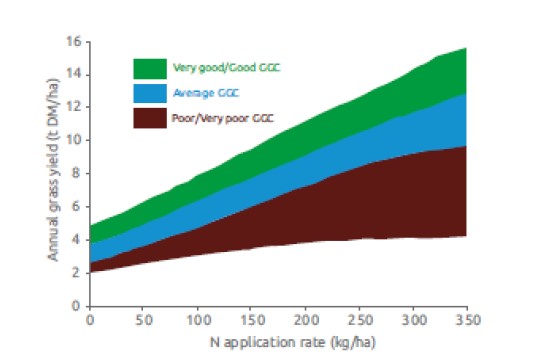- Home
- Knowledge library
- Nitrogen efficiency in rotational grazing systems
Nitrogen efficiency in rotational grazing systems
The focus of this section of our rotational grazing system series for suckler producers is using nitrogen to achieve the desired level of grass production.
The level of fertilisation required by grassland depends on its soil nitrogen supply (SNS) status, the growth potential of the land, termed the ‘Grass Growth Class’, and the level of production of the system.

Indicative grass dry matter yield by grass growth class (GGC). Grass swards greater than three years old with minimal clover and low to moderate soil nitrogen supply (SNS).
Balancing these elements means that the N applied to grass can be tailored to make the most efficient use of the soil nitrogen supply to achieve the desired level of production. Most intensively managed pasture has a high soil nitrogen supply status as a result of dung and urine returned to the soil during grazing and the application of organic manures.
Nitrogen fertiliser should be applied to stimulate early-season growth and then every time the pasture has been grazed down to the post-graze point during the spring/summer. In practice, the first N application should be made when soil temperature reaches a minimum of 5oC at 10 cm depth on three consecutive days and ground conditions permit – usually from mid-February onwards.
Recommendations from the Nutrient Management Guide (RB209) can be seen in the table below. The recommendations are applicable to grass swards with low clover content in a very good/good grass growth class (GGC) and moderate soil nitrogen supply (SNS) situation.
If clover is present, these nitrogen recommendations need to be reduced. Always consult with a FACTS-qualified adviser
|
Nitrogen application rate (kg N/ha) per grazing rotation and approximate application date |
||||||||
|
Indicative DM yielda (t/ha) |
Jan/Feb |
March |
April |
May |
June |
Julyc |
Augustc |
Total N |
|
4 - 5 |
|
30 |
|
|
|
|
|
30 |
|
5 - 7 |
|
30 |
|
20 |
|
|
|
50 |
|
6 - 8 |
|
30 |
|
30 |
|
20 |
|
80 |
|
7 - 9 |
|
40 |
|
30 |
30 |
30 |
|
130 |
|
9 - 12 |
|
30 |
30 |
30 |
30 |
30 |
30 |
180 |
|
10 - 13 |
30b |
40 |
40 |
30 |
30 |
30 |
30 |
230 |
|
12 – 15+ |
30b |
40 |
50 |
50 |
40 |
30 |
30 |
270 |
Nitrogen recommendations for grazed swards
- The recommendations take account of nitrogen recycled at grazing.
- Only applicable to areas with a long grass growing season; the first nitrogen application could be applied as early as mid to late January, with the second application in early March.
- If previous growth has been severely restricted by drought, reduce or omit this application.
Application of N after August is not usually productive due to supply of N from soil organic matter at that time. Check Nitrate Vulnerable Zones (NVZ) rules for guidance on timing.
The nitrogen recommendations from the Nutrient Management Guide (RB209) suggest 30 kg of nitrogen could be applied in late August for systems aiming to produce more than 9 t DM per ha. However, the guide fails to understand the principles of extended grazing during the spring and the autumn. Applications of nitrogen in the early spring and early autumn can allow farms to graze for longer, reducing the housing period and, therefore, applications at these times will also benefit farms with lower stocking rates. Therefore, by applying nitrogen in late August, you can build a grass wedge for autumn and winter grazing. There can be a risk of poor nitrogen use efficiency and leaching if nitrogen is applied too late into the autumn.
Top tips for applying fertiliser in the spring
Paddocks or fields that have heavy covers of grass built up on them (10 cm+) from the previous autumn and over the winter should be grazed before applying N.
Paddocks with little or no grass covers should receive cattle slurry first and N at a later date. These will be the last to be grazed in the first rotation.
Target your earliest N applications on the fields that have the greatest production potential - predominantly ryegrass swards - with 5 cm to 8 cm of grass that have good fertility (pH, phosphate and potash).
Topics:
Sectors:
Tags:



